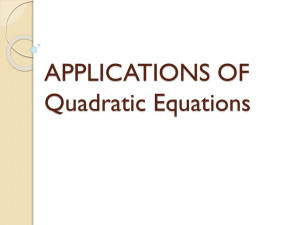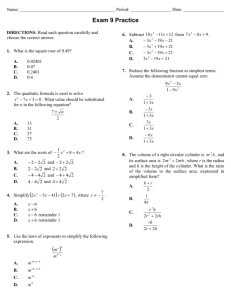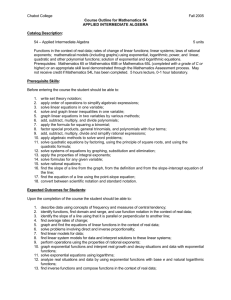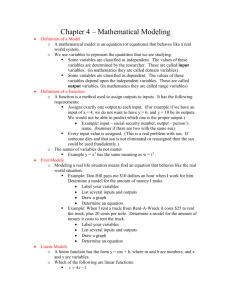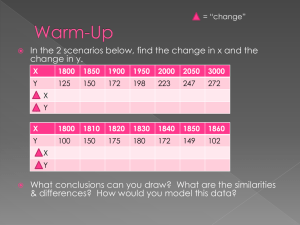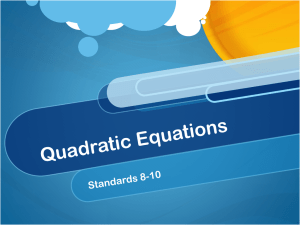Review for Exam 3
advertisement
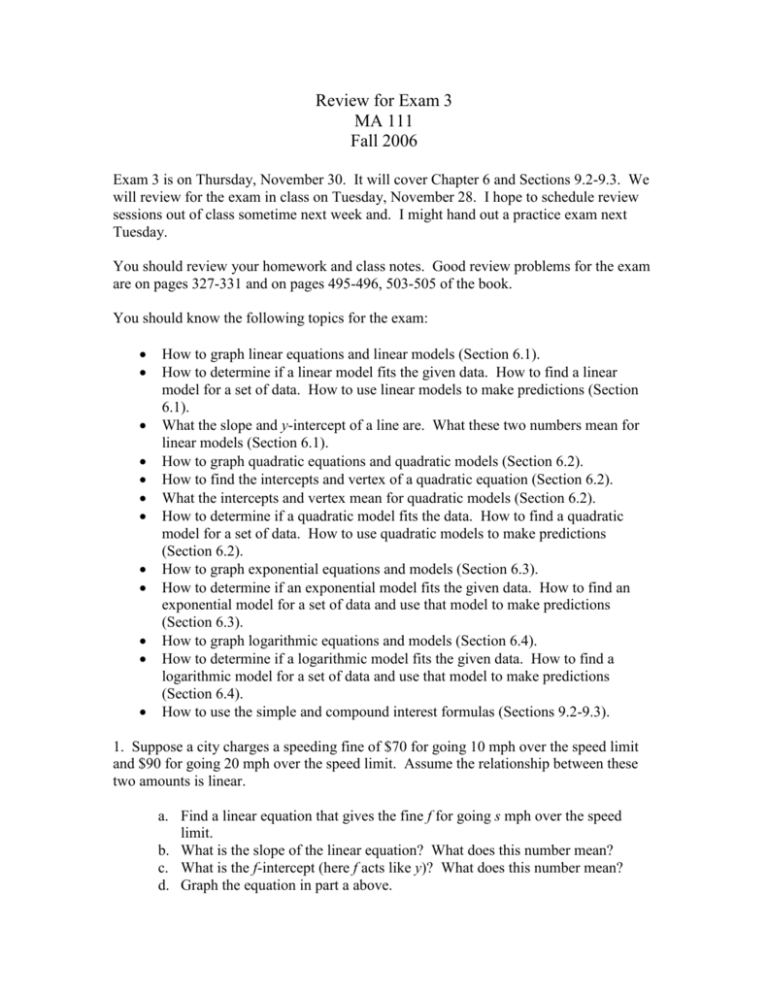
Review for Exam 3 MA 111 Fall 2006 Exam 3 is on Thursday, November 30. It will cover Chapter 6 and Sections 9.2-9.3. We will review for the exam in class on Tuesday, November 28. I hope to schedule review sessions out of class sometime next week and. I might hand out a practice exam next Tuesday. You should review your homework and class notes. Good review problems for the exam are on pages 327-331 and on pages 495-496, 503-505 of the book. You should know the following topics for the exam: How to graph linear equations and linear models (Section 6.1). How to determine if a linear model fits the given data. How to find a linear model for a set of data. How to use linear models to make predictions (Section 6.1). What the slope and y-intercept of a line are. What these two numbers mean for linear models (Section 6.1). How to graph quadratic equations and quadratic models (Section 6.2). How to find the intercepts and vertex of a quadratic equation (Section 6.2). What the intercepts and vertex mean for quadratic models (Section 6.2). How to determine if a quadratic model fits the data. How to find a quadratic model for a set of data. How to use quadratic models to make predictions (Section 6.2). How to graph exponential equations and models (Section 6.3). How to determine if an exponential model fits the given data. How to find an exponential model for a set of data and use that model to make predictions (Section 6.3). How to graph logarithmic equations and models (Section 6.4). How to determine if a logarithmic model fits the given data. How to find a logarithmic model for a set of data and use that model to make predictions (Section 6.4). How to use the simple and compound interest formulas (Sections 9.2-9.3). 1. Suppose a city charges a speeding fine of $70 for going 10 mph over the speed limit and $90 for going 20 mph over the speed limit. Assume the relationship between these two amounts is linear. a. Find a linear equation that gives the fine f for going s mph over the speed limit. b. What is the slope of the linear equation? What does this number mean? c. What is the f-intercept (here f acts like y)? What does this number mean? d. Graph the equation in part a above. 2. Suppose the profit of a company for the first four years is given as follows: Year 1 2 3 4 Profit $11,000 $20,500 $30,200 $40,150 a. Graph the data. A linear model cannot fit the data exactly. Explain why. However, does it appear that a linear model seems to be a good approximation to the data? b. Use any two of the four points above to find a linear equation that approximates the data. Use the linear model to approximate the profit in year 5. 3. A golf ball is hit into the air. Assume the ground is level. We wish to use a quadratic equation to model the path of the ball. Let x represent the horizontal distance in yards and y represent the vertical distance in feet. When the ball has traveled 80 yards, it is 70 feet in the air, and the ball hits the ground 150 yards away. a. Find a quadratic equation that models the path of the ball. b. What is the maximum height of the ball? 4. Graph the quadratic equation y 3x 6 x 13 by finding the vertex and intercepts. 2 5. A person throws a tennis ball into the air. When he first throws it, the ball is 5 feet above the ground. Two seconds later, the ball is 12 feet above the ground. Finally, after 6 seconds have passed, the ball is 8 feet above the ground. Find a quadratic equation that gives the height h of the ball after t seconds. What is the maximum height of the ball? When does the ball hit the ground? 6. A school of fish begins with 100 fish. The population doubles every 6 months. Assume exponential growth. a. Find an exponential model that gives the population P after t months. Use the kt model P Ce . b. Use the model to predict the population after 3 years. c. When will the population reach 4500? d. Why is this model unreasonable for long-term growth? Use a calculation for a time far into the future to explain your answer. 7. Suppose Joe memorizes a list of 100 words, and assume he remembers the entire list immediately after memorizing the list. The number of words N he remembers after t days is given in the table below: Days 1 2 3 4 5 Number of Words 72 40 28 20 16 a. Graph the data. Does an exponential model approximate the data well? kt b. Use the exponential model N Ce to find an exponential equation that models the data. Use the data for 3 days to find this equation. c. Repeat part b, but now use the data for 2 days to find this equation. d. Which of these two models approximates the data better? Explain your answer. 8. Suppose we now use a logarithmic model instead of an exponential model for number 7 above. We wish to use a logarithmic model of the form N a b ln( t 1). a. Find such a logarithmic model by using the data for 3 days. b. Repeat part a, but use the data for 2 days. c. Which of these two models approximates the data better? Explain your answer. d. Out of these four models, which one do you think is the best model? Use this best model to predict how many words Joe will remember after 10 days. 9. Graph the equations y 5 2 x 1 and y 2 3 log( x 5). 10a. Suppose you deposit $500, and you wish to earn $150 of simple interest at a rate of 7.5% per year. How long must you wait to collect this amount of interest? b. Jack invests $5500 for 18 months. Interest is compounded monthly at an annual interest rate of 9.25%. How much money will Jack have by the end of 18 months? c. Rob invests $4500 at an annual interest rate of 7.66%. Interest is compounded every two months. How long must Rob wait to have a total of $10,000 in the account?
